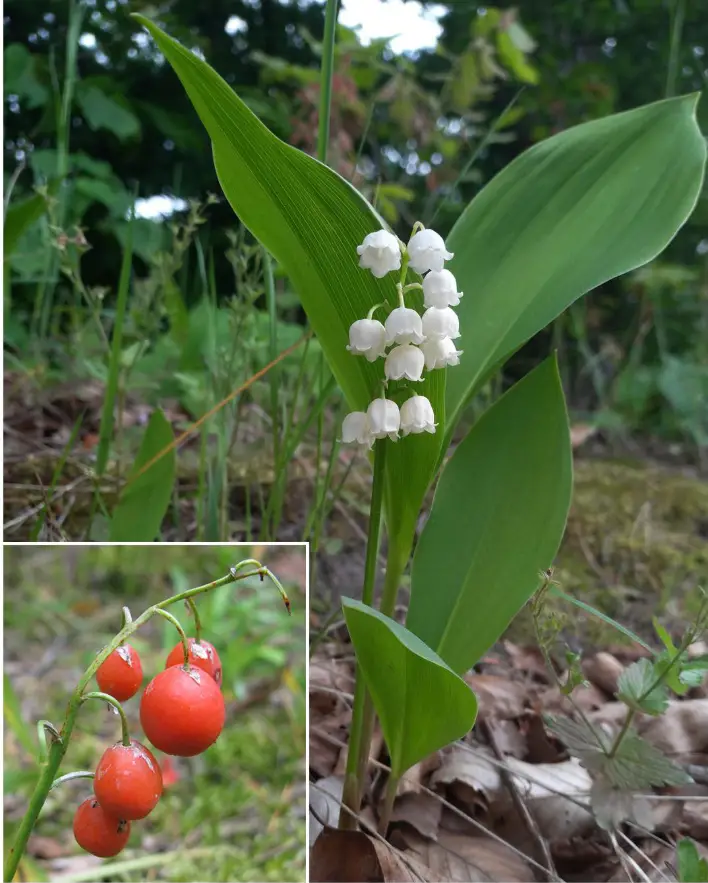Lily of the Valley: A Fragrant but Deadly Garden Beauty
With its delicate white bell-shaped flowers and sweet perfume, Lily of the Valley (Convallaria majalis) is a beloved ornamental plant—but behind its charm lies one of the most toxic plants in temperate gardens. This guide covers identification, toxicity risks, and safety measures for gardeners, pet owners, and foragers.
🔍 Key Identification Features
Visual Characteristics
✔ Flowers:
- Small, waxy, white bell-shaped blooms (5-10mm long)
- Hang in one-sided clusters (5-15 flowers per stem)
- Intensely fragrant (used in luxury perfumes like Dior’s Diorissimo)
✔ Leaves:
- 2-3 broad, lance-shaped leaves per plant
- Parallel veins (unlike wild garlic’s net-like veins)
- Dark green with a glossy surface
✔ Growth Habit:
- Low-growing (15-30 cm tall)
- Spreads aggressively via underground rhizomes
- Forms dense colonies in shady areas
🕵️ How to Distinguish from Look-Alikes
| Feature | Lily of the Valley | Wild Garlic (Edible) |
|---|---|---|
| Smell | Sweet floral | Strong onion/garlic |
| Leaves | Glossy, 2-3 per stem | Matte, multiple per bulb |
| Flowers | White bells | White star-shaped clusters |
| Roots | Rhizomes | Bulbs |
⚠️ Critical Note: When not flowering, leaves can resemble ramps or wild garlic—always crush a leaf to check the smell before foraging!
☠️ Toxicity: Why This Plant is Dangerous
Toxic Compounds
- Cardiac glycosides (convallatoxin, convallamarin)
- Similar to digitalis (foxglove) but 3x more potent
- All parts are poisonous—even the water in a vase holding cut flowers
Symptoms of Poisoning
- 30 mins to 3 hours after ingestion:
- Nausea, vomiting, diarrhea
- Irregular heartbeat (bradycardia or arrhythmia)
- Confusion, hallucinations
- Severe cases:
- Seizures, cardiac arrest, death
At-Risk Groups
- Children (attracted to red berries that form in late summer)
- Pets (dogs, cats, and horses—0.5mg/kg can be lethal)
- Foragers (mistaken for wild garlic or ramps)
🛡️ Safety Measures for Gardeners & Parents
Preventing Accidental Poisoning
✅ Plant with caution:
- Avoid planting near play areas, vegetable gardens, or pet zones
- Use raised containers to limit spreading
✅ Safe handling:
- Wear gloves when pruning/transplanting
- Wash hands immediately after contact
✅ Emergency preparedness:
- Post poison control numbers nearby
- Teach children: “Never touch or eat unknown plants”
What to Do If Ingested
- Do NOT induce vomiting (can worsen heart effects)
- Call Poison Control immediately:
- US: 1-800-222-1222
- UK: 999
- EU: 112
- For pets: Rush to emergency vet
💐 Can You Still Enjoy This Plant Safely?
✔ Yes—with precautions:
- Admire its beauty in controlled garden settings
- Use as cut flowers (keep out of reach of kids/pets)
- Enjoy its scent in perfumes or potpourri (processed safely)
❌ Never:
- Make homemade “remedies”
- Use in food/drinks (some fatal cases from mistaken herbal teas)
- Allow pets/children unsupervised access
🌿 Historical & Cultural Significance
- Medicinal past: Used in controlled doses for heart conditions (now replaced by safer drugs)
- Folklore symbol: Represents humility, luck, and the return of happiness
- Royal favorite: Kate Middleton’s wedding bouquet featured Lily of the Valley
Final Thoughts
Lily of the Valley is a stunning but deadly garden classic. By respecting its toxicity and taking simple precautions, you can safely enjoy its beauty without risk.
Want a printable safety guide? Let me know—I’d be happy to create one!
Have you encountered this plant? Share your experiences below! ⚠️🌿
